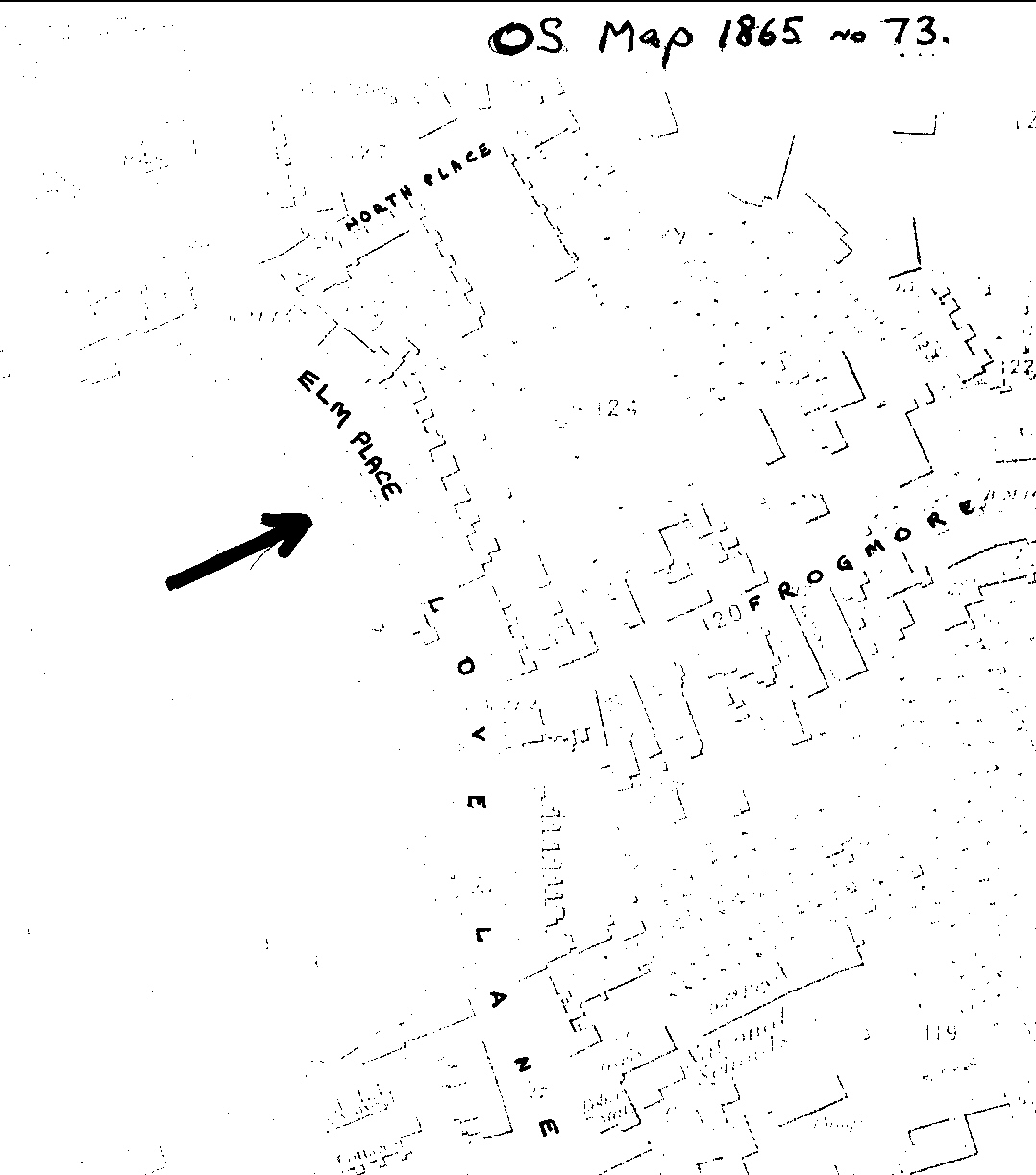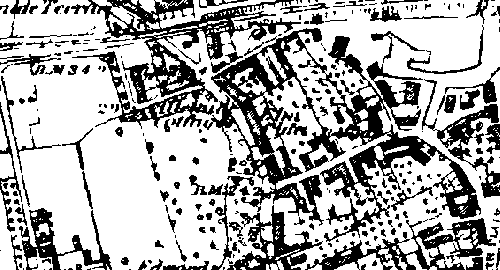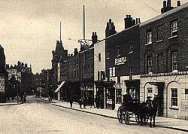![]()
Pratt Family History
![]()
|
Pratt Family History |
|
George PRATT 18..
-18..
married Ann HEMMING (about 1835)
Children:
* Henry born 20 September 1838, at Wandsworth, Surrey, England.
* George born 1840, at Wandsworth, Surrey, England. Occupation Butler
The Birth Certificate of Henry PRATT showed the family was living at Elm Place, Wandsworth at the time of Henry's birth in 1838, a short walking distance from the Bakery at Love Lane where George was the proprietor.
ELM PLACE,
WANDSWORTH, SURREY
George was a Baker at Love Lane,
Wandsworth SW18-4RS, a short distance south of the River Thames. He was listed
as a Baker in the 1838 & 39 Pigots directory.
What is now known as Putney Bridge Road
was previously Wandsworth Lane, Elm Place and Love Lane, being renamed sometime after 1881 (Love Lane is listed in the
1881 Census). Elm Place ran between North Place and Frogmore Lane, where a
terrace of houses stood on the East side of Love Lane.
Other merchants in Love Lane listed in 1838 & 39 Pigots directory
were:
* George Mater - Cow Keepers and Fly & Landau Owners (for hire)
* Frances Atkinson - Fruiterers & Greengrocers
* William Rawlings - Grocers & Dealers in Sundries
* Richard Young - Stone & Marble Masons
* William Prig - Tailors
* Wandsworth Police Station was built at Love Lane in 1839 where Armoury Way now
runs, but was demolished in 1892.





Elm Place Arrowed
The following maps and history are by courtesy of the Wandsworth Museum.

1862 map of Elm Place (arrowed) that merges with Love Lane.

1865 map of Elm Place and Love Lane.

Area about Elm Place and Love lane in 1874


History of Surrey
In the 7th century,
Surrey was part of the kingdom of Mercia, but in 823 it passed to Wessex. By the
time of the Norman invasion it formed part of the kingdom of Harold II, and it
was ruthlessly subjugated by William the Conqueror's army. The most important
date in the county's history is undoubtedly 1215, when King John was forced by
the barons to sign Magna Carta at Runnymede. During the English Civil War, the
county was mostly on the side of the parliamentarians, but a number of
skirmishes with Royalists was fought, and the strongholds of Farnham and
Kingston changed hands several times before Oliver Cromwell's forces finally
triumphed.
The main activity in the county during the Middle Ages was sheep-farming. By the 16th century a textile industry had grown at Farnham, Godalming, and Guildford, and market gardening had begun to be of importance. Hunting took place in Surrey's forests—Henry VIII built a house at Nonsuch Park as a hunting lodge—and the timber was used as fuel in the iron-smelting furnaces of the Sussex Weald, and for shipbuilding. About 1618 the medicinal springs at Epsom were discovered (giving the name to Epsom Salts), and it remained a popular spa during the 17th and 18th centuries. In 1801 the Surrey Iron Railway became the first public railway to be sanctioned by Parliament, running from Merstham to Wandsworth, and using horses to draw the trains.
History of Wandsworth
The boundaries marking the London Borough of Wandsworth were
established in 1965 by merging the former metropolitan borough of Battersea with
approximately two-thirds of what then constituted Wandsworth. The area the
borough covers has one thousand years of recorded history and has archaeological
evidence of communities predating that.
Some of the history of towns in the borough can be found from the links below.
The history of Wandsworth dates from prehistoric times to the present day. Battersea, Balham, Putney, Earlsfield, Roehampton, Wandsworth and Southfields grew from country villages to London's biggest borough.
| It is thought that Wandsworth
got its name from a Saxon tribal leader known as Wendel - Wendelsworth
meaning the place of Wendel, the river Wandle of course also later
adopted his name. It was the river that was to play the vital role in the development of Wandsworth town and by 1805 the river was the busiest in England with over 40 water mills on it's banks. The Middle or Brazil Mill was used for scarlet dye making in Tudor and Stuart times - Wandsworth being renowned all over Europe for the quality of its products. |
|
 As the 19th Century beckoned, the corn mills were producing enough
flour for the whole of London. Brewing too has long been established
here and the Young's brewery on the High Street can be traced back to
1675 with the present Young family taking over in 1830.
As the 19th Century beckoned, the corn mills were producing enough
flour for the whole of London. Brewing too has long been established
here and the Young's brewery on the High Street can be traced back to
1675 with the present Young family taking over in 1830.
Wandsworth
High Street from St Anne's
Hill
- 1900
|
|
|
The High Street was always an important coaching route
from the City of London to Southampton and Portsmouth - then, as now,
presenting a bustling scene. |
|
| Battersea was the site of a Saxon settlement (Batrices Ege) and its manor once belonged to the Abbey of Westminster. The area was a market garden for London with successive draining of the marshland producing fine farmland until the coming of the railways when extensive tracks were laid throughout. The railways, of course, brought industrialisation and Battersea has a rich heritage from the 19th century. | |
 The parish church of St Mary is set by the river off Battersea Church
Road close to the heart of the original village. The present building
dates from 1775 although a church is believed to have stood on the site
since before Norman times. Old Battersea House in nearby Vicarage
Crescent boasts a sundial dated 1699 but the house itself is older
still.
The parish church of St Mary is set by the river off Battersea Church
Road close to the heart of the original village. The present building
dates from 1775 although a church is believed to have stood on the site
since before Norman times. Old Battersea House in nearby Vicarage
Crescent boasts a sundial dated 1699 but the house itself is older
still.Battersea Bridge was rebuilt in 1890 with the current structure replacing a wooden bridge (late 18th century) that was the subject of a nocturne by the American-born artist James McNeill Whistler. Church of St Mary - Battersea |
|
|
Battersea Park, has a turbulent history
to rival Putney. In 1671 Thomas Blood hid in the marsh near what is now
the boating lake, to shoot King Charles II as he bathed; and in 1829 the
Duke of Wellington, when Prime Minister, fought a duel here with Lord
Winchilsea over his introduction of the Catholic Emancipation Bill. |
|
| Clapham in the
centre of the borough is famous mainly for Clapham Junction station -
reputedly the busiest station in Europe. Before the railways arrived,
Clapham was a country crossroads and favourite stop for the gentry travelling
between London and the estates of the home counties. The department store Arding and Hobbs that together with the station dominates Clapham has been there since 1885 and is a good example of Victorian architecture on the grand scale. Clapham Common is an alternatively sedate park and a wild common land. Graham Greene's book, The End of the Affair - reflects the sometimes bleak aspect of the common and the recent film starring Ralf Fines was largely made on location in the area. On a more historical note, the Clapham Sect was a group of evangelical Christians, centred on the church of John Venn, rector of Clapham. The group were prominent in England from about 1790 to 1830, campaigning for the abolition of slavery and promoting missionary work at home and abroad. Much credit for the abolition of slavery and the slave trade in Britain was given to Venn and his compatriots. |
|
| The Nine Elms district to the east of the borough has always been the most industrialised part of the borough. Apart from the relocated Covent Garden Market and the old Power Station, it's best known building is probably the Battersea Dogs Home which has been a haven for the capital's strays for over a century. | |
|
Putney High Street at junction with Upper Richmond Road, c.1890 In the west, the present day calm of Putney conceals an altogether more turbulent past. The notorious highwayman Jerry Abershaw operated here on the Portsmouth Road. Hanged at Kennington, his body was hung in chains on Wimbledon Common near the scene of his exploits. |
|
 Thomas Cromwell, whilst still a Royal courtier to the Tudors, owned a
house in the village and was an early commuter to the palaces to the
west of London.
Thomas Cromwell, whilst still a Royal courtier to the Tudors, owned a
house in the village and was an early commuter to the palaces to the
west of London.Duels were fought here too on Putney Heath with celebrated combatants including William Pitt and Lord Castlereagh - lined up against George Canning. Oliver Cromwell - former resident of Putney |
|
| Putney itself was the site of a
Roman settlement and was subsequently an Anglo Saxon settlement named 'Puttas
Landing', Putta presumably being a Saxon chief who arrived here during
the invasions of the dark ages. Originally a fishing and framing
community, Putney can claim to be one of London's first suburbs. Ever since the first bridge was built here in 1729 - replacing an ancient ferry - Putney has been an important route out of London, but away from the busy High Street a quite and tranquil part of London. The start of the historic University Boat Race takes place at Putney Embankment and can be followed along the beautiful Putney towpath to the finish at Mortlake. |
|
 Roehampton
High Street - Circa 1902 Roehampton
High Street - Circa 1902
Roehampton
has traditionally been a popular residential area. One of the finest
buildings - Roehampton House was built in 1710 and stands today as the
administrative centre of the Queen Mary's Hospital complex. |
|
This page was created using MS FrontPage 2000, and a bit of HTML. Nothing here is intended to be a breach of Copyright, and the graphics shown were either created by me, or are Copyright of their individual owners.